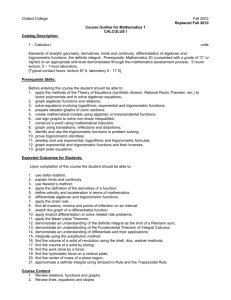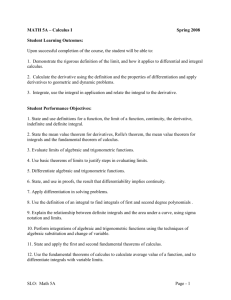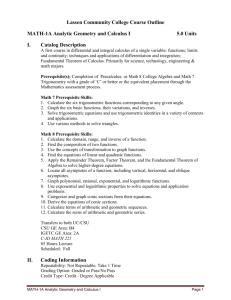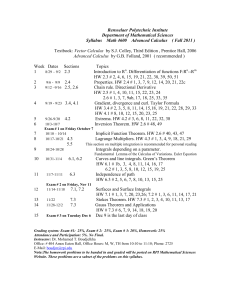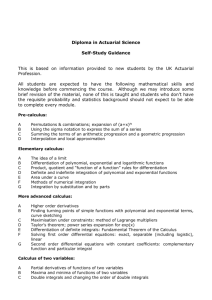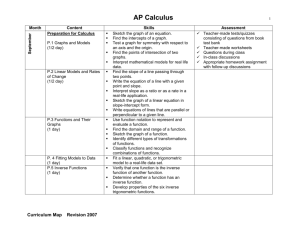Calculus I - Las Positas College
advertisement
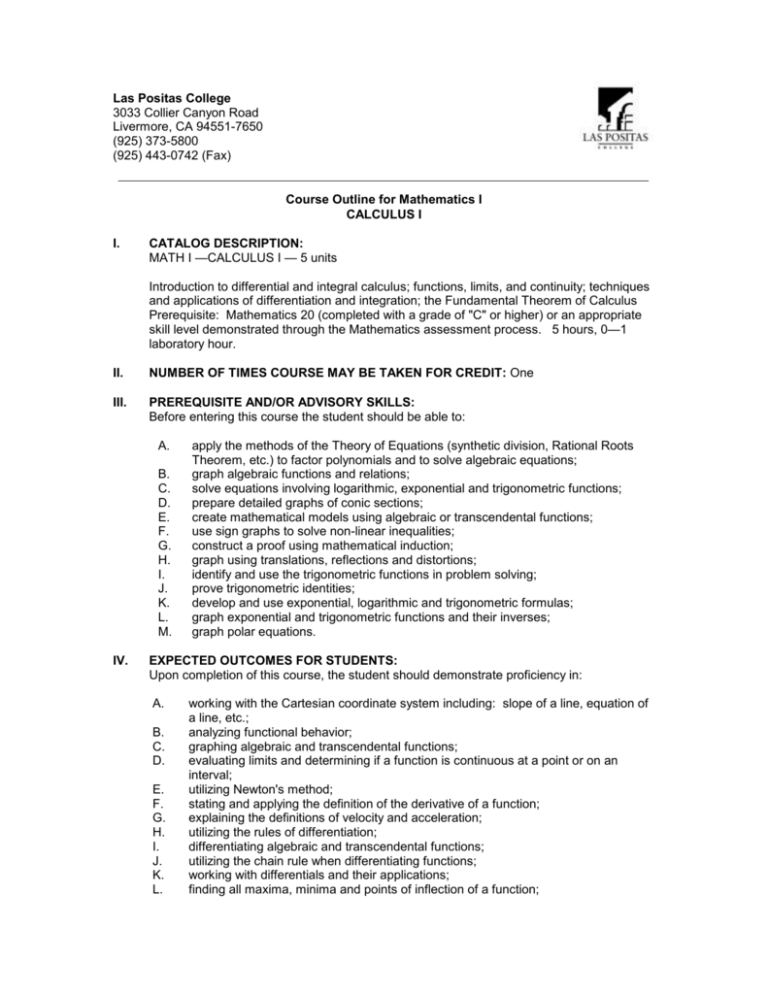
Las Positas College 3033 Collier Canyon Road Livermore, CA 94551-7650 (925) 373-5800 (925) 443-0742 (Fax) Course Outline for Mathematics I CALCULUS I I. CATALOG DESCRIPTION: MATH I —CALCULUS I — 5 units Introduction to differential and integral calculus; functions, limits, and continuity; techniques and applications of differentiation and integration; the Fundamental Theorem of Calculus Prerequisite: Mathematics 20 (completed with a grade of "C" or higher) or an appropriate skill level demonstrated through the Mathematics assessment process. 5 hours, 0—1 laboratory hour. II. NUMBER OF TIMES COURSE MAY BE TAKEN FOR CREDIT: One III. PREREQUISITE AND/OR ADVISORY SKILLS: Before entering this course the student should be able to: A. B. C. D. E. F. G. H. I. J. K. L. M. IV. apply the methods of the Theory of Equations (synthetic division, Rational Roots Theorem, etc.) to factor polynomials and to solve algebraic equations; graph algebraic functions and relations; solve equations involving logarithmic, exponential and trigonometric functions; prepare detailed graphs of conic sections; create mathematical models using algebraic or transcendental functions; use sign graphs to solve non-linear inequalities; construct a proof using mathematical induction; graph using translations, reflections and distortions; identify and use the trigonometric functions in problem solving; prove trigonometric identities; develop and use exponential, logarithmic and trigonometric formulas; graph exponential and trigonometric functions and their inverses; graph polar equations. EXPECTED OUTCOMES FOR STUDENTS: Upon completion of this course, the student should demonstrate proficiency in: A. B. C. D. E. F. G. H. I. J. K. L. working with the Cartesian coordinate system including: slope of a line, equation of a line, etc.; analyzing functional behavior; graphing algebraic and transcendental functions; evaluating limits and determining if a function is continuous at a point or on an interval; utilizing Newton's method; stating and applying the definition of the derivative of a function; explaining the definitions of velocity and acceleration; utilizing the rules of differentiation; differentiating algebraic and transcendental functions; utilizing the chain rule when differentiating functions; working with differentials and their applications; finding all maxima, minima and points of inflection of a function; Course Outline for Mathematics I Page 2 CALCULUS I M. V. utilizing the derivative when finding the solution to optimization and related rate problems; N. applying the Mean Value Theorem; O. evaluating a definite integral as the limit of a Riemann sum; P. applying the Fundamental Theorem of Integral Calculus; Q. evaluating integrals by substitution; R. making use of the definite integral to solve applied problems CONTENT: Core Material: A. B. C. D. E. F. G. H. I. J. K. L. M. N. O. P. Q. R. S. T. U. V. W. X. Y. Z. AA. BB. Relations, functions, graphs Lines: equations and slopes Limits and Continuity Intermediate Value Theorem Secant and Tangent lines Velocity and Acceleration Definition of the Derivative Techniques of Differentiation Chain rule Rate of Change Higher order Derivatives Implicit Differentiation Related rate problems Mean Value Theorem Maxima, minima and points of inflection Curve sketching Asymptotic Behavior of functions Differentials and their applications Newton's method Antiderivatives Riemann sum Definite integral and the Fundamental Theorem of Calculus Mean Value Theorem for the definite integral Average value of a function Integration by substitution Areas of plane regions Volume of solids of revolution Volume of solid by slicing The following material is included depending on textbook selected: A. B. C. D. E. F. VI. Inverse functions Differentiation and Integration of Exponential and Logarithmic functions Work Arc Length Moments, Centers of Mass, and Centroids Fluid Pressure and Fluid Force METHODS OF INSTRUCTION: A. Lectures B. Discussion C. Collaborative learning D. Individual assistance during lab hour Course Outline for Mathematics I Page 3 CALCULUS I VII. TYPICAL ASSIGNMENTS: A. Assigned homework problems are usually from the textbook. A homework set should be assigned at the end of each section. Homework should take an average student 1 to 2 hours for each hour in class. 1. Example Homework problems a. find derivative of f(x) = 3(5 – 2x)² b. find the area between f(x) = x² + 2 and the x-axis on [0,1] B. VIII. A typical Collaborative learning exercise would be to split the class into groups of two to three students, and give each group a different function to differentiate. When they have completed the problem, have each group go to the board and explain how the problem was solved to the rest of the class. EVALUATION: A. Methods of evaluation 1. Examinations 2. Final Exam 3. Any or all of the following at the discretion of the instructor c. Homework d. Quizzes (announced or unannounced, in class or take home) e. Collaborative group activities and labs f. Projects B. Frequency of evaluation 1. Recommended minimum of 4 exams plus the final. C. Types of Problems: 1. Most questions should be open-ended. a. Use the Intermediate Value Theorem to show that there is a root of the equation x³ ― 3x + 1= 0 on the interval (0, 1). b. Find the derivative of f(x)= cos (a³ + x³). c. Evaluate ∫ sin³ΘcosΘdΘ. d. A right circular cylinder is inscribed in a sphere of radius r. Find the largest possible surface area of such a cylinder. e. Find the area of the region enclosed by the curves: y² = x and x ― 2y = 3. 2. Use multiple choice and true-false questions at a minimum and only where appropriate. IX. TYPICAL TEXTS: A. Stewart, Calculus, 4th edition, Brooks/Cole, 1999. B. Larson/Hostetler/Edwards, Calculus with Analytic Geometry, 7th edition, Houghton Mifflin, 2002. C. Anton, Calculus: A New Horizon, 6th edition, Wiley, 1999. X. OTHER MATERIALS REQUIRED OF STUDENTS: A calculator may be required. Creation Date: 01/94 Revision Date: 02/95, 11/02 Date Approved by Curriculum Committee: 2/12/03 Effective Date: Fall 2003

